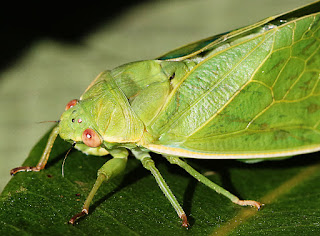Took almost an hour of searching for anything insecty to turn up the above pair this week. Usually only see these cicadas when they've fallen victim to larger birds.
Much messing about in annoying breeze produced few shots in focus. Yesterday, walked from patch of bush, felt something crawling up leg. Yep. Bladder cicada. None for months. Then three. Just like the buses: none, then three come (maths whizzes can explain the buses).
Next to young Rufous-throated Honeyeater (age shown in white edge to gape: back of beak). This bird picked away at growth on branch. Just the stuff for a nest, right? Yes, but ... but bird's too young for the job. Seemed to realise this and moments later let material fall. Copying elders? I don't know.
Now Crimson Finch male. They're building nests all over Tyto. They build, female inspects. Often he's wasted his time. She flies off, dissatisfied. But the males persist and will continue building even after rejection, or when site limitations make the job impossible. (Depth of the oval nest with entry from one end appears to be critical).
On to Cotton Pigmy-goose. Pair today swam onto leaves of pink lotus and used their support to assist with preeening. Years of watching the birds and suddenly a simple action I've never before seen.
And behaviour that's always puzzled me: why Scrub Pythons are so passive. This 2.5metre beauty beside a Tyto track is in prime health and not so laden with recent meal as to be immobile. But with hidey hole close by and crushing strength Scrub Pythons often just sit out any encounter.
This one didn't even flick a tongue out till the lens was 30cm away. It beats me. Buty I love them all.












I really love reading your blog. Great photos in this post like always. I love the behavior of those Cotton Pygmy Geese. Never seen anything like that.
ReplyDeleteI might have some insight on the snake. In my experience, the behavior of snakes changes according to time of day and year. They are often more alert and defensive at night.
My thinking is that instinct leads them to remain motionless, especially in the heat of the day, hoping to avoid being noticed, by prey and predator alike. Things change in cooler nightime temps.
I have encountered this behavior in many species of snakes in captivity and the wild. When I worked in the reptile house of the Santa Barbara Zoo many years ago, I noticed that many snakes find a comfortable spot and do not move except to drink, hunt, shed, mate or defecate. They also move to seek optimal temperatures. Other than that they may remain motionless for weeks on end.
Thanks for that, John. My penchant for brevity left unsaid the extreme differences in behaviour between dangerous Browns and Taipans - more than able, and willing, to defend themselves - and pythons.
ReplyDeleteAwesome photos, especially of the python!
ReplyDelete